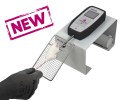Authors
JM Laitila, EL McNamara, CD Wingate, H Goullee et al
Lab
Folkhälsan Institute of Genetics, Folkhälsan Research Center, Biomedicum, Helsinki, Finland
Journal
Acta Neuropathologica Communications
Abstract
Nemaline myopathy (NM) caused by mutations in the gene encoding nebulin (NEB) accounts for at least 50% of all NM cases worldwide, representing a significant disease burden. Most NEB-NM patients have autosomal recessive disease due to a compound heterozygous genotype. Of the few murine models developed for NEB-NM, most are Neb knockout models rather than harbouring Neb mutations. Additionally, some models have a very severe phenotype that limits their application for evaluating disease progression and potential therapies. No existing murine models possess compound heterozygous Neb mutations that reflect the genotype and resulting phenotype present in most patients. We aimed to develop a murine model that more closely matched the underlying genetics of NEB-NM, which could assist elucidation of the pathogenetic mechanisms underlying the disease. Here, we have characterised a mouse strain with compound heterozygous Neb mutations; one missense (p.Tyr2303His), affecting a conserved actin-binding site and one nonsense mutation (p.Tyr935*), introducing a premature stop codon early in the protein. Our studies reveal that this compound heterozygous model, NebY2303H, Y935X, has striking skeletal muscle pathology including nemaline bodies. In vitro whole muscle and single myofibre physiology studies also demonstrate functional perturbations. However, no reduction in lifespan was noted. Therefore, NebY2303H,Y935X mice recapitulate human NEB-NM and are a much needed addition to the NEB-NM mouse model collection. The moderate phenotype also makes this an appropriate model for studying NEB-NM pathogenesis, and could potentially be suitable for testing therapeutic applications.
BIOSEB Instruments Used:
Grip strength test (BIO-GS3)

 Pain - Thermal Allodynia / Hyperalgesia
Pain - Thermal Allodynia / Hyperalgesia Pain - Spontaneous Pain - Postural Deficit
Pain - Spontaneous Pain - Postural Deficit Pain - Mechanical Allodynia / Hyperalgesia
Pain - Mechanical Allodynia / Hyperalgesia Learning/Memory - Attention - Addiction
Learning/Memory - Attention - Addiction Physiology & Respiratory Research
Physiology & Respiratory Research
 Pain
Pain Central Nervous System (CNS)
Central Nervous System (CNS) Neurodegeneration
Neurodegeneration Sensory system
Sensory system Motor control
Motor control Mood Disorders
Mood Disorders Other disorders
Other disorders Muscular system
Muscular system Joints
Joints Metabolism
Metabolism Cross-disciplinary subjects
Cross-disciplinary subjects Happy new year 2025
Happy new year 2025 